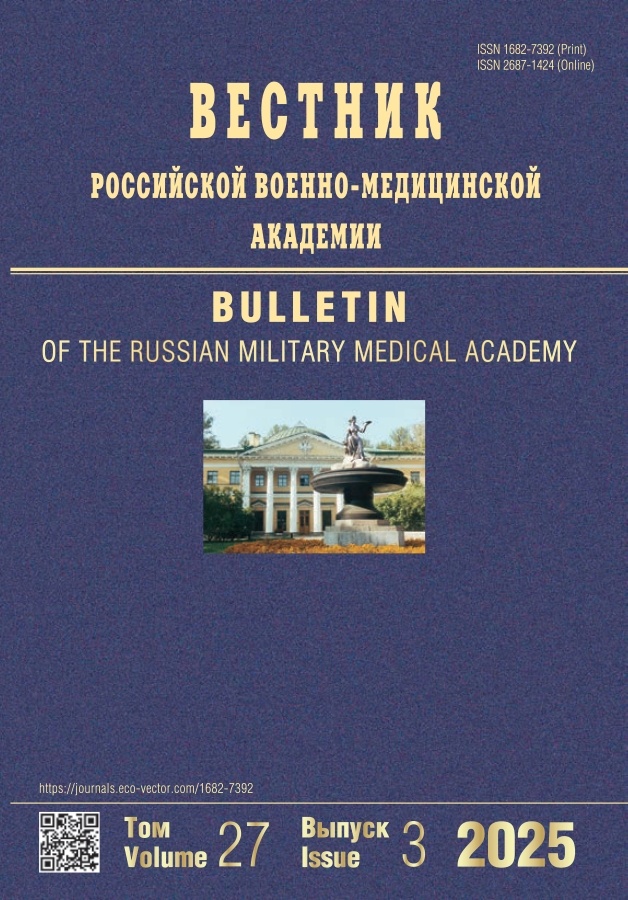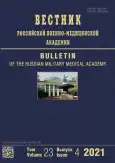Application aspects of medications for inhalation at the prehospital stage of medical evacuation
- 作者: Ivanov I.M.1, Ivchenko E.V.1,2, Yudin M.A.1, Vengerovich N.G.1, Nikiforov A.S.1, Drachev I.S.1, Stepanov A.V.1
-
隶属关系:
- State Research Testing Institute of Military Medicine of the Ministry of Defense of the Russian Federation
- Military Medical Academy named after S.M. Kirov of the Ministry of Defense of the Russian Federation
- 期: 卷 23, 编号 4 (2021)
- 页面: 247-256
- 栏目: Reviews
- URL: https://journals.rcsi.science/1682-7392/article/view/58989
- DOI: https://doi.org/10.17816/brmma58989
- ID: 58989
如何引用文章
详细
This study aimed to determine the aspects of inhalation application of drugs as medical means of protection against lesions by factors of radiation, chemical, and biological nature at the prehospital stage of medical evacuation. Advantages of inhalation administration of drugs and use of individual inhalers of portable type over parenteral and oral administration methods are described. The existing drugs that are most suitable for inhalation at the prehospital stage of medical evacuation include emergency prevention and treatment of toxic pulmonary edema, analgesics, antiradiation, drugs for arresting radiation primary reaction, agents for accelerated radionuclides elimination, and antibacterial and antiviral agents. This list is conditioned by the rapid achievement of the protective effect of the drug during inhalation, both due to the local action in the area of the “entrance gate” of the intake of damaging agents and the accelerated absorption and systemic action on target organs. This study presents data on existing and promising inhalation drugs (antidotes for warfare agents, recombinant forms of acetyl- and butyrylcholinesterase) and technical means of their delivery (a metered aerosol inhaler, a metered dry powder inhaler) in the Armed Forces of the European North Atlantic Treaty Organization bloc and the United States for the prevention and treatment of damage e to chemical agents, as well as the prospects of radiomitigator usage (granulocyte-macrophage colony-stimulating factor) by inhalations for acute radiation syndrome treatment and inhalation of complexones of radioactive isotopes. The prospects of inhalation in combination with bronchodilators in the development of acute respiratory failure and toxic pulmonary edema on the background of poisoning with the use of a metered-dose powder inhaler are described. The introduction and use of a metered-dose dry powder inhaler at the prehospital stage of medical evacuation determines the need for its development, taking into account the specifics of the drug usage, as well as the need to unify the dosage form of drugs in combination with one type of inhaler (single-dose or multi-dose).
作者简介
Igor Ivanov
State Research Testing Institute of Military Medicine of the Ministry of Defense of the Russian Federation
Email: igor611ivanov@gmail.com
SPIN 代码: 1518-3306
candidate of medical sciences
俄罗斯联邦, Saint-PetersburgEvgeniy Ivchenko
State Research Testing Institute of Military Medicine of the Ministry of Defense of the Russian Federation; Military Medical Academy named after S.M. Kirov of the Ministry of Defense of the Russian Federation
Email: 8333535@mail.ru
ORCID iD: 0000-0001-5582-1111
SPIN 代码: 5228-1527
doctor of medical sciences, associate professor
俄罗斯联邦, Saint-Petersburg; Saint-PetersburgMikhail Yudin
State Research Testing Institute of Military Medicine of the Ministry of Defense of the Russian Federation
Email: mikhail.judin@gmail.com
SPIN 代码: 4763-9666
doctor of medical sciences, associate professor
俄罗斯联邦, Saint-PetersburgNikolay Vengerovich
State Research Testing Institute of Military Medicine of the Ministry of Defense of the Russian Federation
Email: nickolai@vengerovich.ru
SPIN 代码: 6690-9649
doctor of medical sciences
俄罗斯联邦, Saint-PetersburgAlexander Nikiforov
State Research Testing Institute of Military Medicine of the Ministry of Defense of the Russian Federation
Email: nikiforov2004@mail.ru
ORCID iD: 0000-0002-4592-5352
SPIN 代码: 3169-7701
Scopus 作者 ID: 55346287000
doctor of biological sciences, associate professor
俄罗斯联邦, Saint-PetersburgIgor Drachev
State Research Testing Institute of Military Medicine of the Ministry of Defense of the Russian Federation
Email: gniiivm_15@mil.ru
SPIN 代码: 6159-7799
doctor of medical sciences
俄罗斯联邦, Saint-PetersburgAlexander Stepanov
State Research Testing Institute of Military Medicine of the Ministry of Defense of the Russian Federation
编辑信件的主要联系方式.
Email: alexander_58@mail.ru
ORCID iD: 0000-0002-1917-2895
SPIN 代码: 7279-7055
doctor of medical sciences
俄罗斯联邦, Saint-Petersburg参考
- Blinov DV, Akarachkova ES, Orlova AS, et al. New framework for the development of clinical guidelines in Russia. Farmakoekonomika. Modern Pharmacoeconomic and Pharmacoepidemiology. 2019;12(2): 125–144. (In Russ.). doi: 10.17749/2070-4909.2019.12.2.125-144.
- Department of the Army, Marine Corps Combat Development Command, Navy Warfare Development Command, Air Force Doctrine Center. Multiservice tactics, techniques and procedures for treatment of chemical agent casualties and conventional military chemical injuries. USA South Carolina: Create Space Independent Publishing Platform, 2012. 192 p.
- Corcoran TE, Venkataramanan R, Hoffman RM, et al. Systemic delivery of atropine sulfate by the MicroDose Dry-Powder Inhaler. J Aerosol Med Pulm Drug Deliv. 2013;26(1):46–55. doi: 10.1089/JAMP.2011.0948
- Masson P, Nachon F. Cholinesterase reactivators and bioscavengers for pre- and post-exposure treatments of organophosphorus poisoning. J Neurochem. 2017;142(2):26–40. doi: 10.1111/jnc.14026
- Rosenberg YJ, Adams RJ, Hernandez-Abanto S, et al. Pharmacokinetics and immunogenicity of a recombinant human butyrylcholinesterase bioscavenger in macaques following intravenous and pulmonary delivery. Chem Biol Interact. 2015;(242):219–226. DOI: 10.1016/ J.CBI.2015.09.021
- Rosenberg YJ, Fink JB. Creation of a protective pulmonary bioshield against inhaled organophosphates using an aerosolized bioscavenger. Ann N Y Acad. Sci. 2016;1374(1):151–158. doi: 10.1111/NYAS.13106
- Sventitskaya АМ, Orlova AB, Subbotina SN, et al. Prospects for the use of scavengers as antidote therapy for acute poisoning with anticholinesterase substances (literature review). Medline.ru. 2020;21:452–473. (In Russ.).
- Rosenberg YJ, Laube B, Mao L, et al. Pulmonary delivery of an aerosolized recombinant butyrylcholinesterase pretreatment protects against aerosolized paraoxon in macaques. Chem Biol Interact. 2013;203(1):167–171. doi: 10.1016/J.CBI.2012.11.004
- McShane JP, Weers JG, Tarara TЕ, et al. Ciprofloxacin dry power for inhalation (ciprofloxacin DPI): technical design and features of an efficient drug-device combination. Pulm Pharmacol Ther. 2018;50:72–79. doi: 10.1016/J.PUPT.2018.03.005
- Mishra M, Mishra B. Formulation optimization and characterization of spray dried microparticles for inhalation delivery of doxycycline hyclate. Yakugaku Zasshi. 2011;131:1813–1825. doi: 10.1248/YAKUSHI.131.1813
- Respaud R, Marchand D, Pelatd T, et al. Development of a drug delivery system for efficient alveolar delivery of a neutralizing monoclonal antibody to treat pulmonary intoxication to ricin. J Control Release. 2016;28:21–32. doi: 10.1016/J.JCONREL.2016.05.018
- Heslet L, Bay С, Nepper-Christensen S. Acute radiation syndrome (ARS) – treatment of the reduced host defense. Int J of General Med. 2012;(5):105–115. doi: 10.2147/ijgm.s22177
- Heslet L. Trifoilium Aps, Hoersholm, assignee. Granulocyte-macrophage colony stimulating factor for enhancing pulmonary host defense in acute and chronic radiation syndrome, therapeutic radiation interaction and cancer therapy. United States patent US 2014/0023612. 2014 Jan 23.
- Grémy O, Tsapis N, Chau Q, et al. Preferential decorporation of americium by pulmonary administration of DTPA dry powder after inhalation of aged PuO(2) containing americium in rats. Radiat Res. 2010;174(5):637–644. doi: 10.1667/RR2203.1
- Basharin VA, Chepur SV, Tolkach PG, et al. Toksikologiya pulmonotoksikantov. Saint Petersburg; 2021. 88 p. (In Russ.).
- Tyunin МА, Vengerovich NG, Sarana AM, et al. Min specific action of inhalation cholinolytics and 2-adrenergic agonists on external respiration in rats intoxicated with organophosphorous compounds. Toxicological Review. 2014;(2):16–21. (In Russ.).
- Chepur SV, Chubar’ ОV, Halimov YuSh, et al. Metodicheskie rekomendacii po terapii dyhatelnoy nedostatochnosti u porazhennyh otravlyayushimi i vysokotoksichnymi veshestvami na etapah medicinskoy evacuacii. Saint Petersburg; 2016. 55 p. (In Russ.).
- Ivanov IM, Nikiforov AS, Chepur SV, et al. Substantiation of requirements for perspective technical means of inhalational delivery of medicines for application at the stages of medical evacuation. Medline.ru. 2019;20:110–133. (In Russ.).
- Yang MY, Yan Chan JG, Chan H, et al. Pulmonary drug delivery by powder aerosols. J Control Release. 2014;193:228–240. doi: 10.1016/J.JCONREL.2014.04.055
- Zaycev AA, Okovityj SV, Kryukov EV. Kashel’. Мoscow; 2015. 59 p.
补充文件








